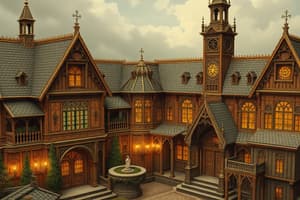Podcast
Questions and Answers
What are the 7 essential building blocks of music?
What are the 7 essential building blocks of music?
Sound, rhythm, tempo, dynamics, melody, harmony, and texture
What are the three secondary aspects of sound used in creating music, as mentioned in the text?
What are the three secondary aspects of sound used in creating music, as mentioned in the text?
Amplitude (volume), duration (sound and silence length), and timbre (tone color).
Which of these is NOT listed as a factor that influences timbre?
Which of these is NOT listed as a factor that influences timbre?
- Sustained pitch
- Attack and articulation
- Vocal cord age and shape
- Pitch of the sound (correct)
- Material qualities of the instrument
What is the name of the musical element that is defined as the frequency at which a sound vibrates?
What is the name of the musical element that is defined as the frequency at which a sound vibrates?
The notes sung in the Alphabet Song correspond to the letter names of musical pitches.
The notes sung in the Alphabet Song correspond to the letter names of musical pitches.
What are the two purposes of a drummer counting from one to four at the beginning of a song in a concert?
What are the two purposes of a drummer counting from one to four at the beginning of a song in a concert?
What is the special unit of measure for tempo?
What is the special unit of measure for tempo?
What are the two Italian terms used to indicate a gradual slow down and a gradual increase in speed, respectively?
What are the two Italian terms used to indicate a gradual slow down and a gradual increase in speed, respectively?
Which of these is NOT a type of scale mentioned in the text?
Which of these is NOT a type of scale mentioned in the text?
What are the two types of melodic movement described in the text?
What are the two types of melodic movement described in the text?
A melody can only move upward or downward.
A melody can only move upward or downward.
What is created when two or more notes are played simultaneously?
What is created when two or more notes are played simultaneously?
What type of chord is commonly used in classical music and rock, consisting of three notes?
What type of chord is commonly used in classical music and rock, consisting of three notes?
What is the name given to a series of chords played linearly?
What is the name given to a series of chords played linearly?
How are chords arpeggiated?
How are chords arpeggiated?
Which type of musical texture is defined by a single line of music?
Which type of musical texture is defined by a single line of music?
Which type of musical texture features a lead melody supported by a harmonic accompaniment?
Which type of musical texture features a lead melody supported by a harmonic accompaniment?
Which type of musical texture involves two or more independent melodies moving at the same time?
Which type of musical texture involves two or more independent melodies moving at the same time?
Which type of musical texture is characterized by multiple voices or instruments performing simultaneously, with at least one deviating slightly from the common melody?
Which type of musical texture is characterized by multiple voices or instruments performing simultaneously, with at least one deviating slightly from the common melody?
What musical element is described as the 'thickness' or 'thinness' of a composition, similar to different pizza styles?
What musical element is described as the 'thickness' or 'thinness' of a composition, similar to different pizza styles?
Flashcards
Sound
Sound
Any audible vibrations perceived by living beings.
Timbre
Timbre
The tone quality or color of a sound, regardless of pitch or volume.
Pitch
Pitch
The frequency of a sound vibration, measured in Hertz.
Note
Note
Signup and view all the flashcards
Melody
Melody
Signup and view all the flashcards
Harmony
Harmony
Signup and view all the flashcards
Rhythm
Rhythm
Signup and view all the flashcards
Tempo
Tempo
Signup and view all the flashcards
Dynamics
Dynamics
Signup and view all the flashcards
Measure
Measure
Signup and view all the flashcards
Meter
Meter
Signup and view all the flashcards
Time Signature
Time Signature
Signup and view all the flashcards
Major Scale
Major Scale
Signup and view all the flashcards
Minor Scale
Minor Scale
Signup and view all the flashcards
Pentatonic Scale
Pentatonic Scale
Signup and view all the flashcards
Stepwise Motion
Stepwise Motion
Signup and view all the flashcards
Leap Motion
Leap Motion
Signup and view all the flashcards
Melodic Contour
Melodic Contour
Signup and view all the flashcards
Chord Progression
Chord Progression
Signup and view all the flashcards
Monophony
Monophony
Signup and view all the flashcards
Homophony
Homophony
Signup and view all the flashcards
Polyphony
Polyphony
Signup and view all the flashcards
Heterophony
Heterophony
Signup and view all the flashcards
Beats Per Minute (BPM)
Beats Per Minute (BPM)
Signup and view all the flashcards
Duple Meter
Duple Meter
Signup and view all the flashcards
Triple Meter
Triple Meter
Signup and view all the flashcards
Quadruple Meter
Quadruple Meter
Signup and view all the flashcards
Study Notes
Musical Elements
- Music is a purposeful arrangement of sounds and silences
- Sound is any vibration audible to living things
- Key properties of sound include:
- Timbre (tone color): differentiates voices/instruments
- Factors influencing timbre: material, vocal cord shape, attack/articulation, sustained pitch
- Descriptive words for timbre: bright, dark, smooth, raspy, etc.
- Pitch: frequency of vibration in Hertz
- Organized into notes (A-G) to create melodies
- Timbre (tone color): differentiates voices/instruments
- Secondary aspects of sound:
- Amplitude (dynamics): volume
- Duration (rhythm): sound and silence length
Rhythm
- Rhythm is created by combining a steady beat with irregular syllables (lyrics)
- Rhythms can be fast or slow, including percussive beats, melodic notes, and rests
- Measures divide musical phrases into smaller units
- Meter: number of beats per measure (duple, triple, quadruple, etc.)
- Time signature: fraction showing meter and note value (numerator = beats, denominator = note value)
Tempo
- Tempo: speed of music, measured in beats per minute (BPM)
- Higher BPM = faster tempo
- Tempo changes within a composition create different moods
- Gradual tempo changes are notated with Italian terms (Ritardando, Accelerando)
Melody
- Melody: sequence of notes played in succession
- Melodic elements:
- Scales (predefined groups of notes)
- Major, minor, pentatonic (different moods)
- Movement (stepwise or leap)
- Contour (path the melody takes)
- Scales (predefined groups of notes)
Harmony
- Harmony: playing two or more notes simultaneously
- Harmony can be consonant (pleasant) or dissonant (unpleasant)
- Created using:
- Intervals (two notes)
- Chords (three or more notes)
- Triads (3-note chords) are common in Western music
- Chord progressions (sequence of chords)
- Chord qualities (e.g., major, minor, augmented, diminished)
- Arpeggiation (breaking chords down into melodies)
Texture
- Texture: the overall sound of a musical composition, like layers in pizza
- Texture types:
- Monophony: one line of music (e.g., acapella singing, guitar solo)
- Homophony: lead melody with harmonic accompaniment (e.g., vocalists with a band)
- Polyphony: two or more independent melodies moving simultaneously (e.g., dueling vocal parts)
- Heterophony: multiple voices/instruments playing the same melody with slight variations (e.g., deviating choruses)
Studying That Suits You
Use AI to generate personalized quizzes and flashcards to suit your learning preferences.




